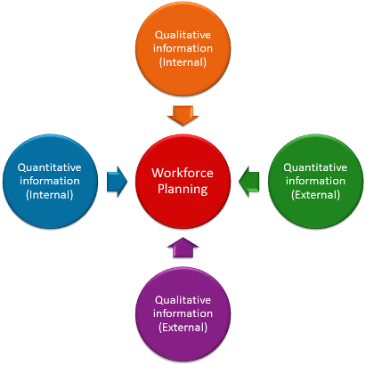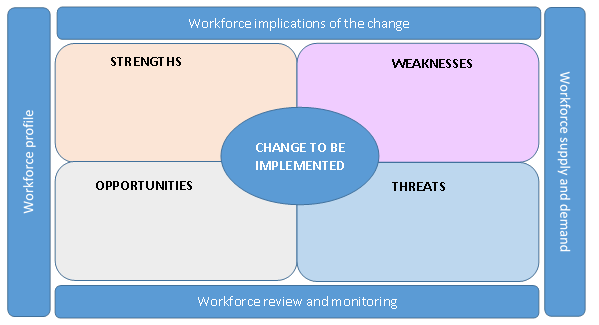1. Introduction
Simply put Workforce Planning is a process to ensure your business has the right number of people with the right skills in the right place at the right time. This lets you allocate resource to a product, project or work area to fulfil day-to-day customer demands, and to deliver your short and long-term objectives.
Alongside this there is a need to create a longer-term workforce plan that ensures not only the best talent is in the right roles today, but that you have an understanding about what sort of workforce is likely to be needed in the future.
The information in this section will help you to:
- understand what is meant by Workforce Planning
- recognise the benefits of Workforce Planning
- know what Workforce Planning involves
- develop your own workforce plan
- use Workforce Planning to adapt to changes and challenges
2. What is Workforce Planning?
- Workforce planning is about generating information, analysing it to inform future demand for people and skills, and translating it into a set of actions that will develop and build on the existing workforce to meet that demand.
- It is future-focussed to enable your business to deliver its existing goals while at the same time remaining flexible enough to deal with changing circumstances.
- It is a dynamic process and should be subject to regular feedback and review.
- It is not just about numbers, but also encompasses other people management practices such as employee skills, potential, training and management development.
- Workforce planning needs to cover the whole organisation and to be effective requires buy-in at all levels. It should look to promote co-operation between managers and minimise any competition between departments for people resources.
- Data from both internal and external sources needs to be brought together and interpreted in a meaningful way.
3. Benefits of Workforce Planning
Effective workforce planning will help you:
- decide how many employees are required and where
- consider what skills these employees need now and in the future
- ensure you have specialist and generic skills within your business
- budget for people related expenditure
- ensure your business is responsive to change
- cope with retirement, people leaving and absences
- link together business and people planning
4. What does Workforce Planning involve?
There is no single formula or template for a workforce plan, but the information typically used is:
- Qualitative information (Internal)
- Quantitative information (External)
- Qualitative information (External)
- Quantitative information (Internal)
5. Developing your own workforce plan
The following questions for each of the headings may act as a useful starting point to plan your workforce requirements:
Qualitative information (Internal)
- What is our long term vision for the business?
- What are the key objectives we wish to achieve over the next 12 months / 2 years….or beyond?
- What are the key targets or results we wish to achieve? (be specific)
- To what extent do the above objectives or targets match our current organisational realities? (e.g. structure, skills)
- What new products, services or projects are there in the pipeline which will require different skills or multi-skilling?
- What internal reviews, evaluations, appraisals or audits have taken place which may influence our staffing and skills needs?
Quantitative information (External)
- How is the labour market changing in our area e.g. demographic forecasts, staff availability, training provision?
- How are our competitors performing on things such as staff turnover, absence levels, training days?
- What industry benchmarking reports or forecasts are there to draw upon to inform our workforce planning?
- What are our customers saying about the skills, knowledge and attitude of our staff?
Qualitative information (External)
- What are the political or environmental developments on the horizon and how will they impact attracting and retaining staff?
- What legislative changes will have greatest impact on our people management and development practices?
- What social trends or attitudes do we need to be mindful of when recruiting or attracting staff?
- What part will technology play in helping or affecting the way we develop, manage and recruit people?
Quantitative information (Internal)
- What is the age, gender, ethnic (or other protected characteristic) profile of our workforce?
- What are our staff working patterns, staff turnover numbers, absence or accident rates?
- What recent data do we have from e.g. staff satisfaction surveys, customer feedback, turnover, to help us plan for the future?
6. Workforce Planning for change
Planning and regularly reviewing your workforce, as identified in this section, lets your business better adapt to changes and challenges within and without of your control.
Getting a clear picture of the profile of your current workforce will support the planning of future capacity and capability needs. Some areas to consider are:
| Structural Profile | Characteristics Profile |
|---|---|
| Type of employment | Gender |
| Type and number of roles | Ethnicity |
| Skills and qualifications | Age |
| Vacancies | Pay rates / grades |
| Location | |
| Nationality |
7. Models to use for Workforce Planning
To fully understand the implications of change on your workforce, there are two models available to use.
Workforce SWOT: A SWOT analysis will let you identify the strengths and weaknesses of your workforce planning, and clarify the opportunities and threats you need to adapt your workforce to.
Some further questions to consider for your SWOT are:
- Is your workforce profile up-to-date?
- Will a re-structuring be needed?
- Will the change need
- an increase or decrease in staff?
- staff to transfer to other locations or parts of the business?
- work patterns to increase or decrease?
- Is your recruitment approach able to deliver the increase you need?
- Have you got
- the right combination of skills across all work areas?
- the right business skills in your management team?
- Have you got a process for managing change that allows staff to participate and be involved?
- Have you got a communications plan to keep staff engaged and motivated, and to explain the effects on them and the culture of the business?
PESTLE: A PESTLE analysis will help you look at a broad landscape of factors that lead to changes to your workforce planning: political, economic, sociological, technological, legal and environmental.
You can find more information on using PESTLE in the context of Brexit and the impact of that change by visiting:
https://www.cipd.co.uk/Images/brexit-workforce-planning-guide_tcm18-38797.pdf
8. Workforce Planning - Top Tips
- Consider what information will be relevant. Do not try to include too much or too many data sources or you could end up suffering ‘paralysis by analysis’.
- Think about whether your business has good quality, easily accessible data or will there be a lot of effort in pulling it together.
- Remember the emphasis is on workforce planning. Conclusions, forecasts or even educated guesses will need to be made by you or your team from the data. Workforce planning is not often an exact science.
- Make sure you adopt a collaborative approach to workforce planning and that you support managers to act on the plan in the best interests of the business as a whole - and not just their own departments or projects.
- Don’t leave measurement and evaluation as an afterthought. Your workforce planning process must consider what criteria will be used to assess the success of the plan; how and when will it be reviewed and refreshed; and how the outcomes will feedback into the next planning process.
- Consider how you will manage the change process to prepare your business and staff to effectively adapt. Do develop a communications plan to support the informing and up-dating of staff.
- Use readily available guidance to help plan, change and diversify your workforce:
Chartered Institute of Personnel and Development (CIPD) useful information and factsheets
https://www.cipd.co.uk/knowledge/strategy/organisational-development/workforce-planning-practice
and
https://www.cipd.co.uk/Images/brexit-workforce-planning-guide_tcm18-38797.pdf
Skills Gateway for Business - Employing disabled people
https://businesswales.gov.wales/skillsgateway/employing-disabled-people
Welsh Language Commissioner - Recruitment: Welsh Language Considerations


